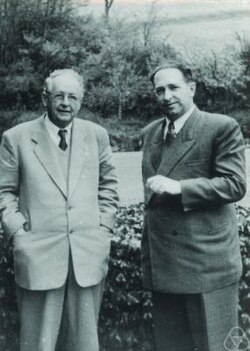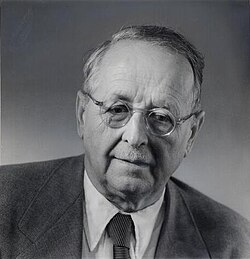„Éė„Éę„Éě„É≥„ÉĽ„ÉĮ„ā§„Éę
„Éė„Éę„Éě„É≥„ÉĽ„āĮ„É©„ā¶„āĻ„ÉĽ„Éē„Éľ„āī„Éľ„ÉĽ„ÉĮ„ā§„ÉęÔľąHermann Klaus Hugo Weyl, 1885ŚĻī11śúą9śó• - 1955ŚĻī12śúą8śó•ÔľČ„ĀĮ„ÄĀ„ÉČ„ā§„ÉĄ„ĀģśēįŚ≠¶ŤÄÖ„Äā„ÉČ„ā§„ÉĄŤ™ě„ĀģÁôļťü≥„ĀęŚĺď„Ā£„Ā¶„Éī„ā°„ā§„Éę„Ā®„āāŤ°®Ť®ė„Āē„āĆ„āč„Äā śēįŤęĖ„ā팟ę„āÄÁīĒÁ≤čśēįŚ≠¶„Ā®ÁźÜŤęĖÁČ©ÁźÜŚ≠¶„ĀģŚŹĆśĖĻ„ĀģŚąÜťáé„Āßť°ēŤĎó„Ā™ś•≠Áłĺ„āíśģč„Āó„Āü„Äā20šłĖÁīÄ„Āę„Āä„ĀĄ„Ā¶śúÄ„āāŚĹĪťüŅŚäõ„Āģ„Āā„āčśēįŚ≠¶ŤÄÖ„Āß„Āā„āč„Ā®„Ā®„āā„Āę„ÄĀŚąĚśúü„Āģ„Éó„É™„É≥„āĻ„Éą„É≥ťęėÁ≠ČÁ†ĒÁ©∂śČÄ„Āģťá捶Ā„Ā™„É°„É≥„Éź„Éľ„Āß„Āā„Ā£„Āü„ÄāÁ†ĒÁ©∂„ĀģŚ§ßŚćä„ĀĮ„Éó„É™„É≥„āĻ„Éą„É≥„Ā®„āĻ„ā§„āĻťÄ£ťā¶Ś∑•ÁßĎŚ§ßŚ≠¶„Āߍ°Ć„āŹ„āĆ„Āü„āā„Āģ„Āß„Āā„Ā£„Āü„ĀĆ„ÄĀ„ÉÄ„Éē„ā£„ÉÉ„Éą„ÉĽ„Éí„Éę„Éô„Éę„Éą„Ā®„Éė„Éę„Éě„É≥„ÉĽ„Éü„É≥„ā≥„Éē„āĻ„ā≠„Éľ„Āę„āą„Ā£„Ā¶ÁĘļÁęč„Āē„āĆ„Āü„ā≤„ÉÉ„ÉÜ„ā£„É≥„ā≤„É≥Ś§ßŚ≠¶„ĀģśēįŚ≠¶„ĀģšľĚÁĶĪ„ĀģÁ∂ôśČŅŤÄÖ„Āß„āā„Āā„Ā£„Āü„Äā „ÉĮ„ā§„Éę„ĀĮÁ©ļťĖď„ÄĀśôāťĖď„ÄĀÁČ©Ť≥™„ÄĀŚď≤Ś≠¶„ÄĀŤęĖÁźÜ„ÄĀŚĮĺÁßįśÄß„ÄĀśēįŚ≠¶ŚŹ≤„Ā™„Ā©„ÄĀŚ§öŚ≤ź„Āęśł°„ā茹ܝáé„Āę„Ā§„ĀĄ„Ā¶Ś§ö„ĀŹ„ĀģŤęĖśĖá„Ā®ŤĎóśõł„āíśģč„Āó„Āü„ÄāŚĹľ„ĀĮšłÄŤą¨ÁõłŚĮĺśÄßÁźÜŤęĖ„Ā®ťõĽÁ£ĀśįóŚ≠¶„āíÁĶź„Ā≥šĽė„ĀĎ„āą„ĀÜ„Ā®„Āó„ĀüśúÄŚąĚ„ĀģšļļÁČ©„ĀģšłÄšļļ„Āß„Āā„āä„ÄĀ„āĘ„É≥„É™„ÉĽ„ÉĚ„āĘ„É≥„āę„ɨ„āĄ„Éí„Éę„Éô„Éę„Éą„ĀģŚĒĪ„Āą„Āü'śôģťĀćšłĽÁĺ©'„Āę„Ā§„ĀĄ„Ā¶„ÄĀŚźĆśôāšĽ£„ĀģŤ™į„āą„āä„āāś∑Ī„ĀŹÁźÜŤß£„Āó„Ā¶„ĀĄ„Āü„ÄāÁČĻ„Āę„Éě„ā§„āĪ„Éę„ÉĽ„āĘ„ÉÜ„ā£„ɧ„ĀĮ„ÄĀśēįŚ≠¶šłä„ĀģŚēŹť°Ć„ĀꌏĖ„āäÁĶĄ„āÄťöõ„ÄĀŚłł„Āę„ÉĮ„ā§„Éę„ĀĆŚÖąŤ°Ć„Āô„āčÁ†ĒÁ©∂„ā퍰ƄĀ£„Ā¶„ĀĄ„Āü„Ā®ŤŅįśáź„Āó„Ā¶„ĀĄ„āč[1]„Äā Áē•ś≠ī„ÉČ„ā§„ÉĄ„Āģ„ÉŹ„É≥„ÉĖ„Éę„āĮ„ĀęŤŅĎ„ĀĄ„ā®„Éę„Ɇ„āĻ„Éõ„Éę„É≥„ĀęÁĒü„Āĺ„āĆ„ÄĀ1904ŚĻī„Āč„āČ1908ŚĻī„Āĺ„Āß„ÄĀ„ā≤„ÉÉ„ÉÜ„ā£„É≥„ā≤„É≥Ś§ßŚ≠¶„Ā®„Éü„É•„É≥„Éė„É≥Ś§ßŚ≠¶„ĀģŚŹĆśĖĻ„ĀßśēįŚ≠¶„Ā®ÁČ©ÁźÜŚ≠¶„āíŚ≠¶„āď„Ā†„Äā„ā≤„ÉÉ„ÉÜ„ā£„É≥„ā≤„É≥Ś§ßŚ≠¶„Āß„ĀĮ„ÄĀśē¨śĄõ„Āô„āč„ÉÄ„Éē„ā£„ÉÉ„Éą„ÉĽ„Éí„Éę„Éô„Éę„Éą„ĀģśĆáŚįé„Āģ„āā„Ā®„Āߌ≠¶šĹć„āíŚĺó„Āü„ÄāśēįŚĻīťĖߌ≠¶„ĀßśēôŤā≤„Āęśźļ„āŹ„Ā£„ĀüŚĺĆ„ÄĀśēįŚ≠¶„Āģ„ÉĚ„āĻ„Éą„āíŚĺó„Ā¶„āĻ„ā§„āĻťÄ£ťā¶Ś∑•ÁßĎŚ§ßŚ≠¶„ĀęÁ߼„āä„ÄĀšłÄŤą¨ÁõłŚĮĺśÄßÁźÜŤęĖ„ĀģÁ†ĒÁ©∂„ā퍰ƄĀ£„Ā¶„ĀĄ„Āü„āĘ„Éę„Éô„Éę„Éą„ÉĽ„āĘ„ā§„É≥„ā∑„É•„āŅ„ā§„É≥„ĀģŚźĆŚÉö„Ā®„Ā™„Ā£„Āü„Äā„āĘ„ā§„É≥„ā∑„É•„āŅ„ā§„É≥„ĀĮ„ÄĀŚĺĆ„ĀęśēįÁźÜÁČ©ÁźÜŚ≠¶„Āßś•≠Áłĺ„āíśģč„Āô„Āď„Ā®„Āę„Ā™„āč„ÉĮ„ā§„Éę„Āꌧ߄Āć„Ā™ŚĹĪťüŅ„āíšłé„Āą„Āü„Äā1921ŚĻī„Āę„ÄĀ„ÉĮ„ā§„Éę„ĀĮ„ÉĀ„É•„Éľ„É™„ÉÉ„É팧ߌ≠¶„Āęśēôśéą„Ā®„Āó„Ā¶Á߼„Ā£„Āü„ā®„Éę„Éī„ā£„É≥„ÉĽ„ā∑„É•„ɨ„Éľ„Éá„ā£„É≥„ā¨„Éľ„Āęšľö„Ā£„Ā¶„ĀĄ„āč„ÄāŚĹľ„āČ„ĀĮ„ĀĚ„ĀģŚĺĆ„āāŤ¶™„Āó„ĀŹšļ§ťöõ„Āó„Āü„Äā „ÉĮ„ā§„Éę„ĀĮ„Éí„Éę„Éô„Éę„Éą„ĀģŚĺĆÁ∂ôŤÄÖ„Ā®„Ā™„āč„Āü„āĀ„ÄĀ1930ŚĻī„Āę„ā≤„ÉÉ„ÉÜ„ā£„É≥„ā≤„É≥„ĀęśąĽ„Ā£„Āü„ĀĆ„ÄĀŚ¶Ľ„ĀƄɶ„ÉĄɧÁ≥Ľ„Āß„Āā„Ā£„Āü„Āü„āĀ„ÄĀ„Éä„ÉĀ„āĻ„ĀģŚäõ„ĀĆŚľ∑„ĀŹ„Ā™„āč„Ā®1933ŚĻī„Āę„ĀĮ„Éó„É™„É≥„āĻ„Éą„É≥ťęėÁ≠ČÁ†ĒÁ©∂śČÄ„ĀęÁ߼„āä„ÄĀ1951ŚĻī„ĀęťÄÄŤĀ∑„Āô„āč„Āĺ„Āß„ĀĚ„Āď„ĀęŚú®ÁĪć„Āó„Āü„Äā„ĀĚ„ĀģŚĺĆ„ĀĮŚ¶Ľ„Ā®„Ā®„āā„Āę„Éó„É™„É≥„āĻ„Éą„É≥„Ā®„ÉĀ„É•„Éľ„É™„ÉÉ„Éí„ĀßťĀé„ĀĒ„Āó„ÄĀ1955ŚĻī„Āę„ÉĀ„É•„Éľ„É™„ÉÉ„Éí„Āßś≠ĽŚéĽ„Āó„Āü„Äā ś•≠Áłĺ Ś§öśßėšĹďŤęĖ„Ā®ÁČ©ÁźÜŚ≠¶„ĀģŚĻĺšĹēŚ≠¶ÁöĄŚüļÁ§éšĽė„ĀĎ1913ŚĻī„ÄĀ„ÉĮ„ā§„Éę„ĀĮ„É™„Éľ„Éě„É≥ťĚĘ„ĀģÁĶĪšłÄÁöĄ„Ā™śČĪ„ĀĄ„ā팏ĮŤÉĹ„Āę„Āó„ĀüŤęĖśĖá„ÄĆ„É™„Éľ„Éě„É≥ťĚĘ„Āģ„āĘ„ā§„Éá„āĘ„Āę„Ā§„ĀĄ„Ā¶„Äć(Die Idee der Riemannschen Fl√§che) „āíÁôļŤ°®„Āó„Āü„Äā„Āď„Āģšł≠„Āß„ÉĮ„ā§„Éę„ĀĮ„ÄĀ„É™„Éľ„Éě„É≥ťĚĘ„ĀģÁźÜŤęĖ„āí„āą„āäŚé≥ŚĮÜ„Āę„Āô„āč„Āü„āĀ„Āę„ÄĀšłÄŤą¨„Éą„ÉĚ„É≠„āł„Éľ„Āģś¶āŚŅĶ„āíÁĒ®„ĀĄ„ÄĀ„ĀĚ„ĀģŚĺĆ„ĀģŚ§öśßėšĹď„ĀģÁ†ĒÁ©∂„ĀęŚĹĪťüŅ„āíšłé„Āą„Āü„Äā„Āď„āĆ„ĀĮ„É©„ā§„ÉĄ„āß„É≥„ÉĽ„ā®„Éí„Éô„Éę„Éą„ā•„āĻ„ÉĽ„ɧ„É≥„ÉĽ„ÉĖ„É©„ā¶„ÉĮ„Éľ„Āģ„Éą„ÉĚ„É≠„āł„Éľ„ĀęťĖĘ„Āô„āčÁ†ĒÁ©∂„Āč„āČ„Éí„É≥„Éą„āíŚĺó„Āü„āā„Āģ„Āß„Āā„āč„Äā „ÉĮ„ā§„Éę„ĀĮ„ā≤„ÉÉ„ÉÜ„ā£„É≥„ā≤„É≥Ś≠¶śīĺ„ĀģšłĽŤ¶ĀšļļÁČ©„Ā®„Āó„Ā¶„ÄĀ„āĘ„ā§„É≥„ā∑„É•„āŅ„ā§„É≥„ĀģÁ†ĒÁ©∂„ā팹̜úü„ĀģśģĶťöé„Āč„āČ„āą„ĀŹÁźÜŤß£„Āó„Ā¶„ĀĄ„Āü„ÄāŚĹľ„ĀĮšłÄŤą¨ÁõłŚĮĺśÄßÁźÜŤęĖ„ĀģÁôļŚĪē„āíŤŅĹ„Ā£„ĀüŤĎóśõł„ÄéÁ©ļťĖď„ÉĽśôāťĖď„ÉĽÁČ©Ť≥™„ÄŹ(Raum, Zeit, Materie) „āí1918ŚĻī„ĀęÁôļŤ°®„Āó„Āü„ĀĆ„ÄĀ„Āď„āĆ„ĀĮŚļÉ„ĀŹŤ™≠„Āĺ„āĆ„ÄĀ1922ŚĻī„Āę„ĀĮÁ¨¨4ÁČą„ĀĆŚáļÁČą„Āē„āĆ„Āü„Äā1918ŚĻī„Āę„ÄĀŚĹľ„ĀĮ„ā≤„Éľ„āł„Āģś¶āŚŅĶ„āíŚįéŚÖ•„Āó„ÄĀÁŹĺŚú®„ā≤„Éľ„āłÁźÜŤęĖ„Ā®„Āó„Ā¶Áü•„āČ„āĆ„Ā¶„ĀĄ„āčśúÄŚąĚ„Āģšĺč„āíšłé„Āą„Āü„Äā„ÉĮ„ā§„Éę„Āģ„ā≤„Éľ„āłÁźÜŤęĖ„ĀĮ„ÄĀťõĽÁ£ĀŚ†ī„Ā®ťáćŚäõŚ†ī„āíśôāÁ©ļ„ĀģŚĻĺšĹēŚ≠¶ÁöĄśÄߍ≥™„Ā®„Āó„Ā¶„ÉĘ„Éá„ÉęŚĆĖ„Āó„āą„ĀÜ„Ā®„Āô„āč„āā„Āģ„Āß„Āā„Ā£„Āü„ĀĆ„ÄĀ„Āď„ĀģŤ©¶„ĀŅ„ĀĮśąźŚäü„Āó„Ā™„Āč„Ā£„Āü„Äā„É™„Éľ„Éě„É≥ŚĻĺšĹēŚ≠¶„Āę„Āä„ĀĎ„āč„ÉĮ„ā§„Éę„ÉĽ„ÉÜ„É≥„āĹ„Éę„ĀĮ„ÄĀŚÖĪŚĹĘŚĻĺšĹēŚ≠¶„ĀģŚüļÁ§é„Ā®„Ā™„āčťá捶Ā„Ā™„āā„Āģ„Āß„Āā„Ā£„Āü„Äā1929ŚĻī„Āę„ÄĀŚĹľ„ĀĮšłÄŤą¨ÁõłŚĮĺśÄßÁźÜŤęĖ„Āę„Āä„ĀĎ„āčŚõõŤĄöŚ†ī (vierbein) „Āģś¶āŚŅĶ„āíŚįéŚÖ•„Āó„Āü[2]„Äā šĹćÁõłÁ姄ÄĀ„É™„ÉľÁ姄ÄĀŤ°®ÁŹĺŤęĖ‚Ü퍩≥Áīį„ĀĮ„ÄĆ„ÉĮ„ā§„Éꚼ£śēį„Äć„ā팏āÁÖß
1923ŚĻī„Āč„āČ1938ŚĻī„Āĺ„Āß„Āę„ÄĀ„ÉĮ„ā§„Éę„ĀĮŤ°ĆŚąóŤ°®ÁŹĺ„ĀęťĖĘ„Āô„āč„ā≥„É≥„ÉĎ„āĮ„ÉąÁ姄ĀģÁźÜŤęĖ„āíśßčÁĮČ„Āó„Āü„Äā„ā≥„É≥„ÉĎ„āĮ„Éą„ÉĽ„É™„ÉľÁ姄ĀģŚ†īŚźą„Āę„Ā§„ĀĄ„Ā¶„ÄĀťá捶Ā„Ā™„ÉĮ„ā§„Éę„ĀģśĆáś®ôŚÖ¨ŚľŹ„ā퍮ľśėé„Āó„Āü„Äā „Āď„āĆ„āČ„ĀģÁĶźśěú„ĀĮ„ÄĀŚĹľ„ĀĆÁ姍ęĖ„Āę„āą„Ā£„Ā¶ŚüļÁ§éšĽė„ĀĎ„ĀüťáŹŚ≠źŚäõŚ≠¶„ĀģŚĮĺÁßį„Ā™śßčťÄ†„āíÁźÜŤß£„Āô„āčšłä„Āßťá捶Ā„Āß„Āā„āč„Äā„āĻ„ÉĒ„Éé„Éę„āā„Āď„āĆ„Āꌟę„Āĺ„āĆ„āč„Äā„āł„Éß„É≥„ÉĽ„Éē„ā©„É≥„ÉĽ„Éé„ā§„Éě„É≥„Āę„āą„āčťáŹŚ≠źŚäõŚ≠¶„ĀģśēįŚ≠¶ÁöĄŚüļÁ§éšĽė„ĀĎ„Ā®„Ā®„āā„Āę„ÄĀ„Āď„āĆ„ĀĮ1930ŚĻīť†É„Āč„āČšłÄŤą¨ÁöĄ„Ā™śČčś≥ē„Ā®„Ā™„Ā£„Āü„Äā„Āĺ„Āü„ÄĀťĚě„ā≥„É≥„ÉĎ„āĮ„ÉąÁ姄Ā®„ĀĚ„ĀģŤ°®ÁŹĺ„ÄĀÁČĻ„Āę„ÉŹ„ā§„āľ„É≥„Éô„Éę„āĮÁ姄Āę„āāś∑Ī„ĀŹťĖĘšŅā„Āó„Ā¶„ĀĄ„āč„Äā„ÉĮ„ā§„Éę„ĀģÁ†ĒÁ©∂šĽ•ťôć„ÄĀ„É™„ÉľÁ姄Ā®„É™„ÉľšĽ£śēį„ĀĮ„ÄĀÁīĒÁ≤čśēįŚ≠¶„Ā®ÁźÜŤęĖÁČ©ÁźÜŚ≠¶„ĀģŚŹĆśĖĻ„ĀßšłĽśĶĀ„Ā®„Ā™„Ā£„Āü„Äā ŚĺĆ„ĀģÁ†ĒÁ©∂„Āꌧ߄Āć„Ā™ŚĹĪťüŅ„āíšłé„Āą„ĀüŚĹľ„ĀģŤĎóśõł„Ä錏§ŚÖłÁ姄ď(The Classical Groups) „Āß„ĀĮ„ÄĀšłćŚ§ČŚľŹŤęĖ„Āę„Ā§„ĀĄ„Ā¶ŚÜćŤÄÉ„Āó„ÄĀŚĮĺÁßįÁ姄ÄĀšłÄŤą¨Á∑öŚěčÁ姄ÄĀÁõīšļ§Á姄ÄĀśĖúšļ§Á姄Ā®„ÄĀ„ĀĚ„ĀģšłćŚ§ČŚľŹ„ÄĀÁ姍°®ÁŹĺ„Āę„Ā§„ĀĄ„Ā¶ŤÄÉŚĮü„Āó„Āü„Äā Ť™ŅŚíĆŤß£śěź„Ā®Ťß£śěźÁöĄśēīśēįŤęĖ„ÉĮ„ā§„Éę„ĀĮ„ÄĀ„Éá„ā£„ā™„Éē„ā°„É≥„Éą„āĻŤŅĎšľľ„Āę„Āä„ĀĎ„ā蚳ĜßėŚąÜŚłÉ mod 1 „Āģ„Āü„āĀ„ĀģŚüļśļĖ„Ā®„Ā®„āā„Āę„ÄĀśĆáśēįŚíĆ„ĀģÁĒ®„ĀĄśĖĻ„āíÁ§ļ„Āó„Āü„Äā„Āď„āĆ„ĀĮŤß£śěźÁöĄśēīśēįŤęĖ„Āģťá捶Ā„Ā™„āĻ„ÉÜ„ÉÉ„Éó„Ā®„Ā™„āč„āā„Āģ„Āß„ÄĀ„Éô„Éę„É≥„ÉŹ„Éę„Éą„ÉĽ„É™„Éľ„Éě„É≥„Āģ„āľ„Éľ„āŅťĖĘśēį„ÄĀŚä†ś≥ēÁöĄśēīśēįŤęĖ„ĀęŚŅúÁĒ®„Āē„āĆ„ÄĀŚ§ö„ĀŹ„ĀģśēįŚ≠¶ŤÄÖ„Āę„āą„Ā£„Ā¶śĒĻŤČĮ„Āē„āĆ„Āü„Äā śēįŚ≠¶ŚüļÁ§éŤęĖŤĎóśõł„ÄéťÄ£Á∂öšĹďŤęĖ„ÄŹ(The Continuum) „Āę„Āä„ĀĄ„Ā¶„ÄĀ„ÉĮ„ā§„Éę„ĀĮ„Éź„Éľ„Éą„É©„É≥„ÉČ„ÉĽ„É©„ÉÉ„āĽ„Éę„ĀģŚěčÁźÜŤęĖ„āíÁĒ®„ĀĄ„Ā¶ťĚ쌏ĮŤŅįÁöĄ„Ā™ŤęĖÁźÜ„āíśßčÁĮČ„Āó„Āü„ÄāŚĹľ„ĀĮŚŹ§ŚÖłÁöĄ„Ā™šĽ£śēįŚ≠¶„Āģ„ĀĽ„Ā®„āď„Ā©„āí„ÄĀśéíšł≠Śĺč„āĄŤÉĆÁźÜś≥ē„ÄĀ„ā≤„ā™„Éę„āĮ„ÉĽ„āę„É≥„Éą„Éľ„Éę„ĀģÁĄ°ťôźťõÜŚźą„āíÁĒ®„ĀĄ„Āö„ĀęśßčÁĮČ„Āô„āč„Āď„Ā®„ĀęśąźŚäü„Āó„Āü„Äā„ÉĮ„ā§„Éę„ĀģśÄĚśÉ≥„ĀĮ„Āď„Āģť†É„ÄĀ„ÉČ„ā§„ÉĄ„Āģ„É≠„Éě„É≥šłĽÁĺ©ŤÄÖ„ÉĽšłĽŤ¶≥ÁöĄŤ¶≥ŚŅĶŤęĖŤÄÖ„Āß„Āā„Ā£„Āü„É®„ÉŹ„É≥„ÉĽ„āī„ÉÉ„Éą„É™„Éľ„Éó„ÉĽ„Éē„ā£„Éí„ÉÜ„ĀģśÄ•ťÄ≤ÁöĄ„Ā™śßčťÄ†šłĽÁĺ©„ĀģŚĹĪťüŅ„ā팏ó„ĀĎ„Ā¶„ĀĄ„āč„Äā „ÄéťÄ£Á∂öšĹďŤęĖ„ÄŹ„āíÁôļŤ°®„Āó„ĀüŚĺĆ„ÄĀ„ÉĮ„ā§„Éę„ĀĮŤá™Ťļę„ĀģÁę茆ī„āí„ÉĖ„É©„ā¶„ÉĮ„Éľ„ĀģŚĒĪ„Āą„āčÁõīŤ¶≥šłĽÁĺ©„ĀęÁ߼„Āó„Āü„Äā„ÄĆťÄ£Á∂öšĹď„Äć„āíśßčśąź„Āô„āčÁāĻ„ĀĮ„ÄĀťõĘśē£ÁöĄ„Ā™ŚģüšĹď„Ā®„Āó„Ā¶Ś≠ėŚú®„Āô„āč„Äā„ÉĮ„ā§„Éę„ĀĮ„ÄĀŚćė„ĀęÁāĻ„ĀģťõÜ„Āĺ„āä„Āß„Ā™„ĀĄ„āā„Āģ„Ā®„Āó„Ā¶„ĀģťÄ£Á∂öšĹď„āíśúõ„āď„Ā†„ÄāŚĹľ„ĀĮŤá™Ťļę„Ā®„ÉĖ„É©„ā¶„ÉĮ„Éľ„Āģ„Āü„āĀ„Āę„ÄĀ„ĀĚ„Āģ„Āď„Ā®„āíŤŅį„ĀĻ„ĀüŤęĖśĖá„ÄĆśąĎ„ÄÖ„ĀĮťĚ©ŚĎĹ„Āß„Āā„āč„Äć(We are the revolution.) „āíÁôļŤ°®„Āó„Āü„Äā„Āď„ĀģŤęĖśĖá„ĀĮ„ÉĖ„É©„ā¶„ÉĮ„ÉľŤá™Ťļę„ĀģšĽēšļč„āą„āä„ĀĮ„āč„Āč„ĀęŚļÉ„ĀĄŚĹĪťüŅ„āíšłé„Āą„ÄĀÁõīŤ¶≥šłĽÁĺ©„ĀģŤ¶čśĖĻ„āíŚļÉ„āĀ„Āü„Äā „āł„Éß„Éľ„āł„ÉĽ„ÉĚ„Éľ„ɧ„Ā®„ÉĮ„ā§„Éę„ĀĮ„ÄĀ1918ŚĻī2śúą9śó•„Āę„ÉĀ„É•„Éľ„É™„ÉÉ„Éí„ĀßťĖč„Āč„āĆ„ĀüśēįŚ≠¶ŤÄÖšľöŤ≠į„Āę„Āä„ĀĄ„Ā¶„ÄĀśēįŚ≠¶„ĀģšĽäŚĺĆ„ĀģśĖĻŚźĎśÄß„Āę„Ā§„ĀĄ„Ā¶„ĀģŤ≥≠„ĀĎ„ā퍰ƄĀ£„Āü„Äā„ÉĮ„ā§„Éę„ĀĮšĽäŚĺĆ20ŚĻī„ĀģťĖď„Āę„ÄĀśēįŚ≠¶„ĀĮŚģüśēį„āĄťõÜŚźą„ÄĀŚŹĮÁģóśÄß„Āģś¶āŚŅĶ„ĀģśõĖśėß„Āē„ā퍙ćŤ≠ė„Āó„ÄĀŚģüśēį„ĀģśúÄŚįŹšłäÁēĆśÄß„ĀģÁúüŚĀĹ„Āę„Ā§„ĀĄ„Ā¶ŚēŹ„ĀÜ„Āģ„ĀĮ„ÄĀ„ā≤„ā™„Éę„āĮ„ÉĽ„Éī„ā£„Éę„Éė„Éę„Ɇ„ÉĽ„Éē„É™„Éľ„ÉČ„É™„Éí„ÉĽ„Éė„Éľ„ā≤„Éę„ĀģŤá™ÁĄ∂Śď≤Ś≠¶„ĀģŚüļśú¨ÁöĄ„Ā™šłĽŚľĶ„ĀģÁúüŚĀĹ„āíŚēŹ„ĀÜ„Āģ„Ā®ŚźĆÁ®čŚļ¶„ĀęśõĖśėß„Āß„Āā„āč„Āď„Ā®„ā퍙ćŤ≠ė„Āô„āč„Āď„Ā®„Āę„Ā™„āč„Ā†„āć„ĀÜ„Ā®šļąśÉ≥„Āó[3]„ÄĀ„ĀĚ„Āģ„āą„ĀÜ„Ā™ÁĖĎŚēŹ„ĀęŚĮĺ„Āô„āčÁ≠Ē„Āą„ĀĮś§úŤ®ľšłćŚŹĮŤÉĹ„Āß„Āā„āä„ÄĀšĹďť®ď„Āô„āč„Āď„Ā®„ĀĆ„Āß„Āć„Āö„ÄĀ„Āó„Āü„ĀĆ„Ā£„Ā¶ÁĄ°śĄŹŚĎ≥„Āß„Āā„āč„Ā®„Āó„Āü„Äā „Āó„Āč„Āó„Ā™„ĀĆ„āČ„ÄĀśēįŚĻī„Āģ„ĀÜ„Ā°„Āę„ÄĀ„ÉĮ„ā§„Éę„ĀĮ„ÉĖ„É©„ā¶„ÉĮ„Éľ„ĀģÁõīŤ¶≥šłĽÁĺ©„ĀĆ„ÄĀśČĻŚą§ŤÄÖ„ĀĆŤ®Ä„ĀÜ„āą„ĀÜ„Āę„ÄĀ„Āā„Āĺ„āä„Āę„āāŚ§ö„ĀŹ„ĀģŚą∂ÁīĄ„āíśēįŚ≠¶„Āęšłé„Āą„āč„Ā®ŤÄÉ„Āą„āč„āą„ĀÜ„Āę„Ā™„Ā£„Āü„Äā„Āď„ĀģŚćĪś©ü„ĀęťĖĘ„Āô„āčŤęĖśĖá„ĀĮ„ÄĀ„ÉĮ„ā§„Éę„ĀģŚĹĘŚľŹšłĽÁĺ©„ĀģŚłę„Āß„Āā„Ā£„Āü„Éí„Éę„Éô„Éę„Éą„ĀģśÄĚśÉ≥„Ā®„ĀĮÁõłŚģĻ„āĆ„Ā™„ĀĄ„āā„Āģ„Āß„Āā„Ā£„Āü„ĀĆ„ÄĀ1920ŚĻīšĽ£„Āę„Ā™„āč„Ā®„ÄĀťÉ®ŚąÜÁöĄ„Ā™„ĀĆ„āȍᙍļę„ĀģÁę茆ī„āí„Éí„Éę„Éô„Éę„Éą„ĀģśÄĚśÉ≥„Ā®Ť™ŅŚíĆ„Āē„Āõ„āč„āą„ĀÜ„Āę„Ā™„Ā£„Āü„Äā 1928ŚĻīť†É„Āč„āČ„ÉĮ„ā§„Éę„ĀĮ„ÄĀśēįŚ≠¶ÁöĄÁõīŤ¶≥šłĽÁĺ©„ĀĮ„ā®„Éą„Ɇ„É≥„Éą„ÉĽ„Éē„ÉÉ„āĶ„Éľ„Éę„ĀģÁŹĺŤĪ°Ś≠¶ÁöĄŚď≤Ś≠¶„ĀęŚĮĺ„Āô„āčŤá™Ťļę„ĀģśÉÖÁÜĪ„Ā®„ĀĮÁõłŚģĻ„āĆ„Ā™„ĀĄ„Ā®ŤÄÉ„Āą„āč„āą„ĀÜ„Āę„Ā™„Ā£„Āü„Äāśô©ŚĻī„ÄĀŚĹľ„ĀĮśēįŚ≠¶„āí„ÄĆŤ®ėŚŹ∑ÁöĄśßčťÄ†ÁČ©„Äć„Ā®ŤÄÉ„Āą„āčÁę茆ī„ā팏Ė„āč„āą„ĀÜ„Āę„Ā™„āä„ÄĀ„Éí„Éę„Éô„Éę„Éą„āĄ„ā®„Éę„É≥„āĻ„Éą„ÉĽ„āę„ÉÉ„ā∑„Éľ„É©„Éľ„ĀģśÄĚśÉ≥„ĀęŤŅĎ„Ā•„ĀĄ„Āü„Äā„Āü„Ā†„Āó„ÄĀ„Āď„āĆ„Āę„Ā§„ĀĄ„Ā¶„ĀĮŚ§ö„ĀŹ„ā퍮ė„Āó„Ā¶„ĀĄ„Ā™„ĀĄ„Äā Ť™ěťĆ≤„ÉĮ„ā§„Éę„ĀģšĽ•šłč„Āģ„ā≥„É°„É≥„Éą„ĀĮ„ÄĀŚĻ匹܌ÜóŤęá„āíšļ§„Āą„Āü„āā„Āģ„Āß„Āā„āč„ĀĆ„ÄĀŚĹľ„ĀģšļļśüĄ„āí„āą„ĀŹŤ°®„Āó„Ā¶„ĀĄ„āč„Äā
ŤĄöś≥®
ŚŹāŤÄÉśĖáÁĆģšłÄś¨°Ť≥áśĖô
ÁŅĽŤ®≥
šļĆś¨°Ť≥áśĖô
Ś§ĖťÉ®„É™„É≥„āĮ
|
||||||||||||||||||||||||||
Portal di Ensiklopedia Dunia















